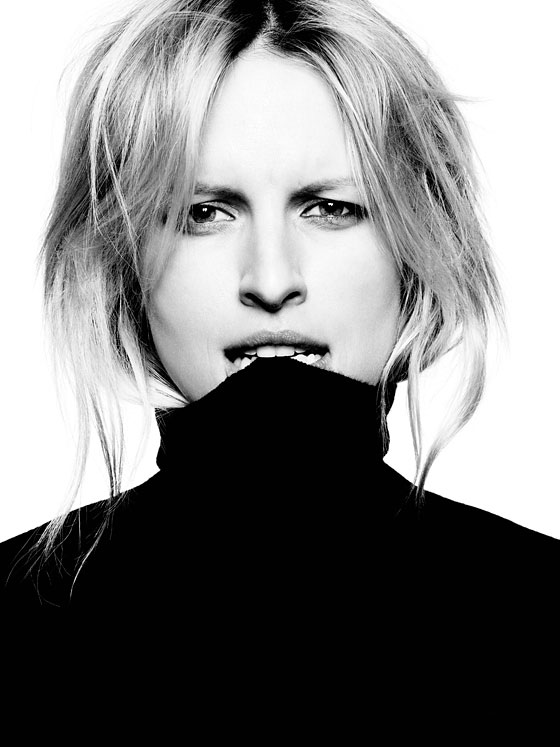Karolina Kurkova, Angela Lindvall, and Coco Rocha plot the future of their relevance.

Karolina Kurkova
(Photo: Ben Hassett; Styling by Ludivine Poiblanc; Hair by Akki; Makeup by Alice Lane for Jed Root Inc.; Manicure by Tracylee for Tim Howard Management. Kurkova wearing Uniqlo turtleneck, available at Uniqlo, 666 Fifth Ave.; 877-486-4756.)
High above New York on the 21st-floor balcony of the Cooper Square Hotel, German television is filming Karolina Kurkova teaching ten aspiring models how to walk a runway. “It literally looks like we’re walking on skyscrapers!” the Czech native, 27, says in enthusiastic English that later will be partially dubbed over in German. The girls, plucked from a Deutschland-wide search, at least pretend to understand. Battling stiff winds and language barriers, Kurkova demonstrates three runway walks: high fashion, couture, and “show,” which basically means pretending to wear giant Victoria’s Secret wings—a technique in which Kurkova is quite expert. Then, to the delight of the Teutonic producers, she gets her heel stuck between floor slats. Her fumbling to free herself is a moment that, along with the many times she bursts into tears eliminating girls, will be played on repeat in stridently dramatic European promos.
The show, called Das Perfekte Model (The Perfect Model), is Kurkova’s first step toward building the kind of career that keeps a model in the spotlight after shoots have dried up. The greatest post-modeling successes in the past decade have been Heidi Klum and Tyra Banks. And not surprisingly, Kurkova and her producers are billing Das Perfekte Model as a toned-down, “documentary-style” counterpart to Klum’s second-best-known TV-hosting gig: the megahit Germany’s Next Topmodel (itself derived from Banks’s Top Model juggernaut). Looming in the background of every model’s career, even one as thriving as Kurkova’s, is the inevitable fear: aging out. The thirst for fresh faces in modeling is so intense that the Council of Fashion Designers of America has issued a plea for designers and modeling agencies not to let girls under 16 walk at New York Fashion Week. Not everybody complies.
So what’s a woman shunned from a girl’s world to do? Try acting (Milla Jovovich, Amber Valetta, Charlize Theron, Cameron Diaz, Tyra Banks), play music (Karen Elson,Irina Lazareanu, Banks again), become a photographer (Helena Christensen, Banks again), start a beauty line (Miranda Kerr), start a yoga line (Christy Turlington), start a clothing line (Kate Moss, Erin Wasson), start a jewelry line (too many to count), start a furniture line (Cindy Crawford), get a bachelor’s in comparative religion and Eastern philosophies (Turlington again), run a charity (where to begin), run for Estonian Parliament (Carmen Kass), marry rich (Stephanie Seymour, Christie Brinkley), or become the First Lady of France (Carla Bruni).
In dance, another industry ruthless in spitting out its genetically gifted workers, there’s actually a foundation for “career transition” funded by the Newhouse family. Modeling has no such safety net. “You’d be stupid not to think you have a shelf life,” says Iman, 56, who now runs a $25 million cosmetics company. “I knew I had to become a brand. And that brand was me.”But the trick for Kurkova and two other models who are thinking hard about their futures—Coco Rocha and Angela Lindvall—is how to build a populist brand without screwing up their still-active careers as high-fashion models.
Put another way: Can a QVC line ever coexist with the cover of Vogue?
The youngest of the three is Rocha, age 23, who’s big enough she got a shout-out in a Kanye West song; Tyra Banks has called her “the queen of posing.” Rocha thought “modeling was just going to be a summer thing and then I’d go home,” she says. “Then I went to Asia. Then I worked with Steven [Meisel].” Now she even has friends like Karlie Kloss, 19, arguably the most famous face of her generation, joking that girls in Rocha’s class (“the old-lady crew,” as Rocha calls them) have stuck around too long. Yet Rocha is convinced she’s found modeling’s holy grail for longevity: social media. “Once I started making noise, I thought, I’m not going anywhere.”
Making noise certainly worked for Heidi Klum, 38, who started her career in 1992—too late to be a supermodel and too curvy to be a waif. Clothes “would get stuck on my boobs,” Klum says. She wound up doing catalogues until she “nagged and nagged and nagged” Victoria’s Secret. She got a publicist, who helped her get Sports Illustrated, which led to Leno, which proved she could do TV, which led to Project Runway and her becoming far more influential in fashion than she ever was as a model.
It also worked for Cindy Crawford, 46. Against her agents’ advice, she took an unpaid job as the first host of MTV’s House of Style, which gave her a new, large, male fan base that led to a huge campaign with Pepsi. “I definitely made a choice to go more all-America,” she says. “I felt that was my brand.”









No comments:
Post a Comment